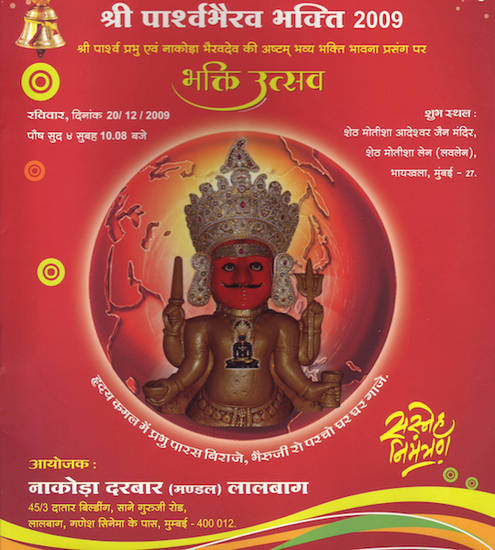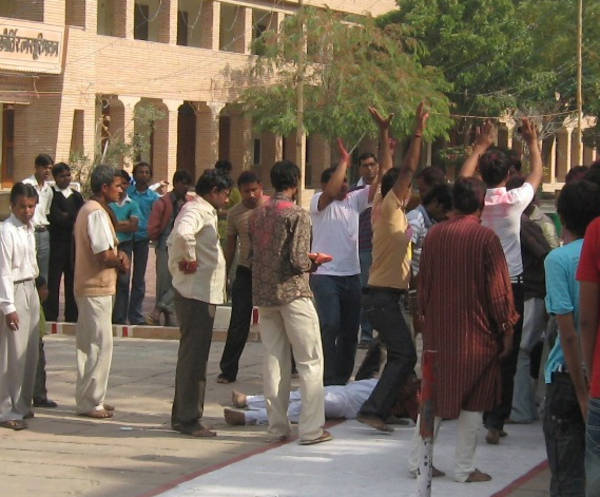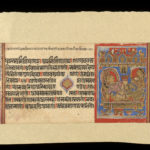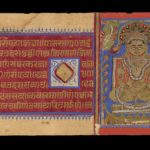Article: Nākoḍā Bhairava
Nākoḍā Bhairava is a protective male deity worshipped in Nākoḍā, a Śvetāmbara Jain pilgrimage site – tīrtha – in western Rajasthan. He is very popular in the Śvetāmbara community, but also well known among Jains in general. Nākoḍā Bhairava is famous for his miraculous powers, granting boons and possessing his devotees.
Many Jains do not condone Nākoḍā Bhairava’s popularity and believe that he has nothing to do with Jainism at all. Even so, both lay and ascetic Jains take part in his cult.
The present statue – mūrti – of Nākoḍā Bhairava was created and ceremoniously installed in the temple dedicated to Pārśvanātha or Lord Pārśva in 1934. Nākoḍā Bhairava is situated next to the temple’s main image, Nākoḍā Pārśvanātha. The statue of the 23rd Jina, Nākoḍā Pārśvanātha, is reported to have been discovered underground in 1455 with the help of Nākoḍā Bhairava.
Nākoḍā Bhairava is particularly popular among Jain shopkeepers, who often keep images of him in their shops. The bhairava appears in various stories connected to the site and is today known for his ability to help devotees achieve various worldly goals such as better health and material gain. The bhairava is also believed to enter the bodies of devotees, effectively possessing them, sometimes communicating auspicious messages through them.
History
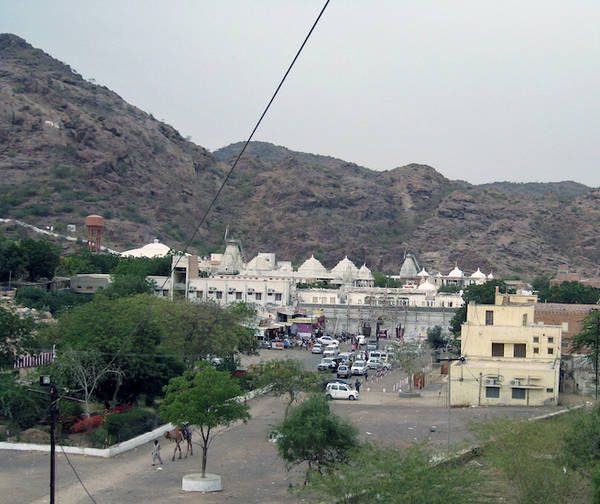
Nākoḍā pilgrimage site
Image by Knut Aukland © Knut Aukland
The story of Nākoḍā Bhairava is connected to the tale of the image of Pārśvanātha or Lord Pārśva in Nākoḍā – Nākoḍā Pārśvanātha. The Nākoḍā Pārśvanātha is the main idol in the temple dedicated to the 23rd Jina. Nākoḍā Bhairava became prominent in the 20th century and is now familiar to most Jains.
According to the site’s own history, Jains have resided in Nākoḍā since the second century following the nirvāṇa of the 24th Jina, Mahāvīra, which is 527 BCE in traditional Śvetāmbara dating. From this time onwards various Jain activities are reported, such as temple constructions and visits from famous monks, including the influential philosopher Haribhadra. There are stories of Jain statues that were hidden underground to protect them from attacks by intolerant rulers and chieftains during the first half of the second millennium. Many such statues were forgotten and some are still dug out today. The statue of Pārśvanātha or Lord Pārśva in Nākoḍā – Nākoḍā Pārśvanātha – was rediscovered in this way in 1455.
According to the story, a Jain lay man had a dream in which Nākoḍā Bhairava told him of the long-forgotten statue of Pārśvanātha or Lord Pārśva, the 23rd Jina, and where it was hidden. The statue was then discovered and installed in the Nākoḍā temple by the Kharatara-gaccha monk Kīrtiratna-sūri. As Kīrtiratna-sūri was carrying the rediscovered statue of Pārśva, people spontaneously formed a procession behind him. They saw Nākoḍā Bhairava in the form of a boy dancing and walking with them, eventually causing them to stop in Nākoḍā. Kīrtiratna-sūri decided to keep the Pārśvanātha statue there and installed the aniconic image – piṇḍākar – of Nākoḍā Bhairava by the temple entrance. Similar stories are found in other pilgrimage sites.
The site was later abandoned until the Tapā-gaccha nun Sundarśrī came to the Nākoḍā temple at the beginning of the 20th century and decided to spend the rest of her life working on its restoration. She raised funds and interest in the site, actively propagating the cult of Nākoḍā Bhairava, which gave rise to her nickname of the ‘Saviour of Nākoḍā Tīrtha’ – tīrthoddhārikā. The official trust overseeing the site was established in 1924.
Origins
The word bhairava is a generic term used all over South Asia to denote some form of deity. It is derived from the Sanskrit verb root bhī, meaning ‘terrible’, ‘frightening’. The name ‘Nākoḍā Bhairava’ thus means the ‘bhairava of Nākoḍā’. Although it is not clear what the nature of Nākoḍā Bhairava and his cult was before he was installed in the Jain temple, it seems reasonable to assume certain points.
Firstly, at some point Nākoḍā Bhairava was a local deity without strong links to Jainism, similar to the many other bhairavas found in Rajasthani villages.
Secondly, it can be assumed that he was incorporated into a more defined sphere of Jain religious activity and infrastructure, much like other protective deities such as the goddess Saciyā Mātā.
The many bhairavas found all over India tend to be associated with the Hindu god Śiva, whose favourite weapon, the trident, is found in one of Nākoḍā Bhairava’s hands. Supporting this connection to Śiva are two things. The first is magic formulas – mantras – in some of the hymns to Nākoḍā Bhairava. Secondly, there are popular emblems with an image of Nākoḍā Bhairava next to a sacred diagram – yantra.
Lay status
While often referred to as a guardian deity – rakṣakdev or adhiṣṭāyak deva – Nākoḍā Bhairava is also understood to be a lay follower of Jainism. This greatly affects the financial standing of the Nākoḍā trust since money donated to Nākoḍā Bhairava is interpreted as being donated to a lay man and not a statue in the system of the seven fields of donation. This gives the trust freedom to direct investment to other things than the construction and refinement of statues and temples, such as the research institution Prakrit Bharati Academy in Jaipur.
Image of Nākoḍā Bhairava
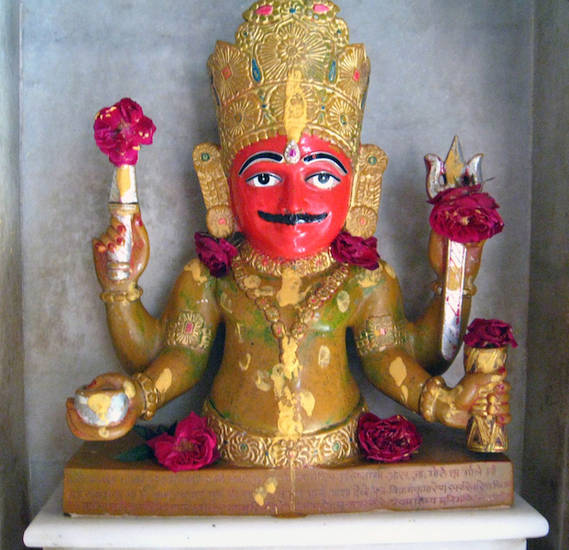
Nākoḍā Bhairava
Image by Knut Aukland © Knut Aukland
In 1934 a new statue of Nākoḍā Bhairava was fashioned on the instruction of Jain mendicants after his true form – svarūp – had been revealed in the dreams and visions of various individuals. One of these was the Tapā-gaccha monk, Himācal-sūri. He installed the three-dimensional bust statue of Nākoḍā Bhairava inside the temple, next to Nākoḍā Pārśvanātha. It replaced the previous image, which did not depict Nākoḍā Bhairava as a human-like figure.
In his present anthropomorphic form, Nākoḍā Bhairava has a red, moustachioed face and four arms. Many gods have four arms in Jain art. In each hand he holds an item associated with bhairavas all over India, namely:
- a bowl – kapāla – in his lower right hand
- a drum – ḍamaru – in his lower left hand
- a sword – khaḍga – in his upper right hand
- a trident – triśūla – in his upper left hand.
Many replicas are found both inside and outside India, reflecting his popularity. These shrines are the scene of religious ceremonies similar to the worship rituals surrounding the original Nākoḍā Bhairava.
Worship
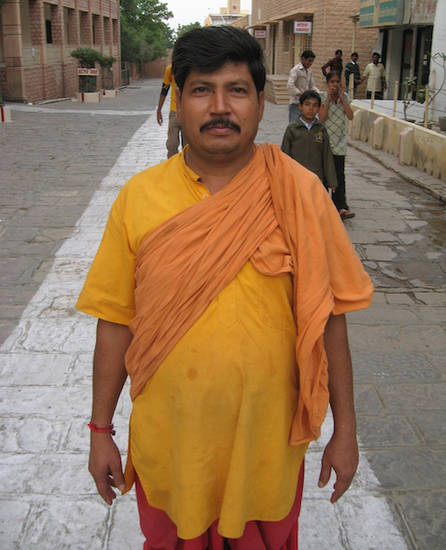
Pujārī
Image by Knut Aukland © Knut Aukland
Although Nākoḍā Bhairava is secondary in the Śvetāmbara temple of Nākoḍā Pārśvanātha, he is a popular figure of worship. Nākoḍā Bhairava is a deity subject to the cycle of rebirth and thus can intervene in the world of human affairs, unlike a Jina who is a liberated soul. Worshippers pray to Nākoḍā Bhairava for help in worldly concerns, particularly wealth. There are two unusual elements associated with the worship of Nākoḍā Bhairava, which are more common in Indian religions in general than among Jains. First, he is well known for possession of his devotees. Secondly, the auspicious offerings of sweets – prasāda – are considered unlucky if taken outside the temple premises.
Morning and evening pūjās and āratīs are held daily for Nākoḍā Bhairava, but always after the main image of Pārśvanātha or Lord Pārśva has been worshipped. The pujārī draws a curtain in front of the closest sitting Pārśva image during the worship of Nākoḍā Bhairava. A way of preventing Pārśva from being offended, the drawing of the curtain is rare in Jain religious practice, although it is familiar to Hindus. All rituals are led by the Hindu pujārīs and the winners of auctions – bolis – held for the various parts of the worship. For the Pārśva idol these offerings include:
- bathing the image – prakṣāl pūjā
- offering saffron – kesar pūjā
- burning incense – dhūp pūjā
- offering perfume – itr pūjā
- offering flowers – puṣpa pūjā
- the final offering of the lamp ceremony – āratī.
The worship of Nākoḍā Bhairava consists of only the last three ceremonies. The highest auction bids are put forward for the lamp ceremony honouring the bhairava. The ritual of the ‘sacred gaze’ – darśana – and donating to the bhairava are both thought to be particularly auspicious during the evening lamp ceremony.
Many worshippers consider Sundays a particularly auspicious day for worship of Nākoḍā Bhairava. Evening gatherings with hymn singing – bhajan – often take place at the weekends or on special occasions.
Many people perform a ‘sacred gaze’ – darśana – of Nākoḍā Bhairava upon arrival. The temple is arranged so that visitors pay their respects to the main figure of Pārśva first. Prayers are often performed while gazing at Nākoḍā Bhairava.
Some devotees report that they donate sums of money they have promised if their wishes are fulfilled. Many Jain businessmen consider Nākoḍā Bhairava to be their business partner and donate percentages of their yearly income to him.
Possession
It is especially during the singing of evening āratīs on Sundays that Nākoḍā Bhairava is known to possess devotees. Some of the possessed devotees will answer questions from the other worshippers on issues of health and future outcomes.
Nākoḍā Bhairava appears to be particularly prone to possess devotees during the yearly fair – melā – held around the birthday of Pārśvanātha or Lord Pārśva. Pārśva’s birthday is celebrated in the festival of Poṣa-daśamī, which falls in late December or early January and is celebrated by all Jain sects.
This is also an occasion where non-Jains come to worship the bhairava. Jains allow non-Jains to take part in the regular worship of the bhairava and he also possesses them at times.
Sweet offerings
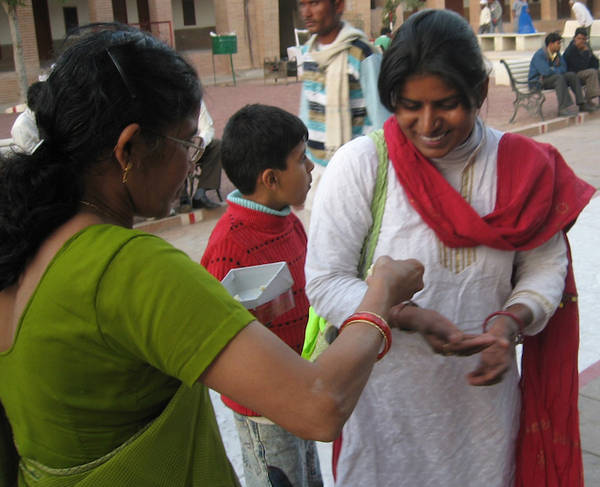
Taking the bhairava’s prasād
Image by Knut Aukland © Knut Aukland
A second unusual tradition relates to sweet offerings given to Nākoḍā Bhairava. A portion of these offerings is kept and later consumed by devotees as auspicious offerings – prasāda. This prasāda is to be eaten within the temple complex. If prasād is taken outside, it is widely believed that some misfortune might happen.
Car accidents and sickness are reported as resulting from breaking this unwritten rule. The local bus driver is known to habitually demand that the passenger who has taken prasād from Nākoḍā should go back and ask for forgiveness whenever his vehicle breaks down.
Reading
- ‘Understanding Possession in Jainism: A Study of Oracular Possession in Nakoda’
Knut Aukland - Modern Asian Studies
edited by Joya Chatterji
volume FirstView
Cambridge University Press; July 2012
- ‘Deity Worship in Nakoda: Religion and Economy in a Jaina Pilgrimage Site’
Knut Aukland - Studies in Jaina History and Culture: Jaina Law
edited by Peter Flügel
Routledge Advances in Jaina Studies series; series editor Peter Flügel; volume 4
Routledge Curzon Press; London, UK; 2013 – forthcoming
- Absent Lord: Ascetics and Kings in a Jain Ritual Culture
Lawrence A. Babb - Comparative Studies in Religion & Society series; volume 8
University of California Press; Berkeley, California, USA; 1996
- ‘Worship of Bell-Ears the Great Hero: A Jain Tantric Deity’
John E. Cort - Tantra in Practice
edited by David Gordon White
Princeton Readings in Religions series; series editor Donald S. Lopez Jr.; volume 8
Princeton University Press; Princeton, New Jersey, USA and Oxford, UK; 2000
- Jains in the World: Religious Values and Ideology in India
John E. Cort - Oxford University Press USA; New York, USA; 2001
- Nākoḍā Tīrthaoddhārikā: Pravartinī Sādhvī Śrī Sundarśrījī
Bhurcand Jain - Arihant Prakāśān; Bāṛmer, Rajasthan, India; 2005
- Riches and Renunciation: Religion, Economy and Society among the Jains
James Laidlaw - Oxford Studies in Social and Cultural Anthropology series
Oxford University Press; Oxford, UK; 1995
- World Renowned Jain Pilgrimages: Reverence and Art
Mahopadhyaya L. Sagar - Prakrit Bharati Academy; Jaipur, Rajasthan, India; 2000
- Śrī Nākoḍā Pārśvanāth Tīrtha Itīhās
Campālāl Sālecā - edited by Prem Bhandarī
Jñān Prakāśan; Jodhpur, Rajasthan, India; no date
Links
- Shri Nakoda Ji Jain Temple
-
The Shri Nakoda Ji Jain Temple website presents information about the Śvetāmbara temple in Nakoda, Rajasthan, dedicated to Pārśvanātha or Lord Pārśva, the 23rd Jina. Website visitors can perform online worship ceremonies to the cult figure of Nākoḍā Bhairava.
- Nākoḍā Bhairava
-
The Nakoda Bhairav website provides information about the Śvetāmbara temple at Nakoda, Rajasthan but focuses on presenting hymns, pictures and songs celebrating the Śvetāmbara protective deity Nākoḍā Bhairava. Website visitors can read and listen to hymns and download them, along with pictures of Nākoḍā Bhairava's statue. There is also an e-book in Hindi to read online or download.
- Jai Nakoda Bhairav
-
A Facebook group called Jai Nakoda Bhairav provides pictures and information in Hindi about the Śvetāmbara guardian god Nākoḍā Bhairava.
- Nakoda Bhairav group
-
A Facebook group called Nakoda Bhairav provides information in Hindi and lots of picture of images of the Śvetāmbara guardian god Nākoḍā Bhairava.
- NaKoDa Ji ThE jAIN tirTH group
-
A Facebook group called NaKoDa Ji ThE jAIN tirTH provides information in Hindi about the popular Śvetāmbara deity Nākoḍā Bhairava, including pictures of various images of him.
- Nākoḍā Bhairava in California
-
Facebook provides a picture of an idol of the Śvetāmbara protective god Nākoḍā Bhairava housed in the Jain Center of Northern California, in Milpitas, California.
- Nākoḍā Bhairava ceremony
-
This YouTube video from 2010 records a Śvetāmbara 'great lamp ceremony' – mahāratī – performed in front of a Nākoḍā Bhairava image in Indore, Madhya Pradesh. A possessed man is seen in the second half of the film. The scenes are very similar to those seen in Nākoḍā, Rajasthan, where the original Nākoḍā Bhairava statue is situated.
- Song to Nākoḍā Bhairava
-
A song dedicated to Nākoḍā Bhairava, the protective Śvetāmbara deity in Rajasthan, is available to listen to or download from Soundcloud.
- Mahāratī to Nākoḍā Bhairava
-
A recording of a Śvetāmbara 'great lamp ceremony' – mahāratī – to Nākoḍā Bhairava, sung by a group of male and female singers, is available to listen to or download from Soundcloud.
- +
- aAbhavya
- aAbhinandana
- aAbhiṣeka
- aĀcāra
- aĀcārāṅga-sūtra
- aĀcārya
- aAchalbhrata
- aAḍhāī-dvīpa
- aAdharma
- aAdho-loka
- aAdhyayana
- aAdvaita Vedānta
- aĀgama
- aAghātīya
- aAghātīya-karman
- aAgnibhuti
- aAgra
- aĀhāra
- aAhiṃsā
- aAhimsa Day
- aAjita
- aAjīva
- aAkampit
- aĀkāśa
- aAkbar the Great
- aAkṣaya-tṛtīyā
- aAlauddin Khalji
- aAlbert Einstein
- aAllah
- aAlms
- aĀlocanā
- aAloka-ākāśa
- aAmāri
- aAmbikā or Kūṣmāṇḍinī
- aAnagāra
- aAnanta
- aAnarthadaṇḍa
- aAnaśana
- aAnekānta-vāda
- aAṅga
- aAniconism
- aAnojjā
- aAntarāla
- aAntarāya-karma
- aAṇu
- aAṇu-vrata
- aAnukampā
- aAnuprekṣā
- aAnusvāra
- aApabhraṃśa
- aAparigraha
- aAra
- aĀrambha
- aĀrambhaja
- aĀratī
- aArdhamāgadhī Prākrit
- aArhaṃ
- aArhat
- aArśana-āvaraṇīya-karma
- aĀrta-dhyāna
- aĀryikā
- aĀryikā Jñānamati
- aĀśātanā
- aĀścarya
- aAscetic
- aAsceticism
- aAshram
- aAspiration
- aĀsrava
- aAṣṭa-maṅgala
- aAṣṭāpada
- aAstikāya
- aAstrolabe
- aAsura
- aAtheism
- aAticāra
- aAtiśayakṣetra
- aAtithisaṃvibhāgavrata
- aĀtma-vāda
- aĀtman
- aAuṃ
- aAurangzeb
- aAuspicious
- aAusterity
- aAvadhāna
- aAvadhi-jñāna
- aĀvaraṇī-yakarman
- aAvasarpiṇī
- aAvatāra
- aAvidyā
- aAxiom
- aĀyāga-paṭa
- aĀyambil
- aĀyu-karma
- aĀyurveda
- bBabur
- bBāhubali
- bBaladeva
- bBālāvabodha
- bBandha
- bBasadi
- bBazaar
- bBhadrankarvijay
- bBhagavant
- bBhaktāmara-stotra
- bBhakti
- bBhale
- bBharata
- bBhāṣā
- bBhāṣya
- bBhaṭṭāraka
- bBhāva
- bBhāva-pūjā
- bBhāvanā
- bBhavana-vāsin
- bBhavya
- bBhavyatva
- bBhaya
- bBhoga-bhūmi
- bBhogopabhoga
- bBodhi
- bBollywood
- bBrahmā
- bBrahma-deva
- bBrahmacārī
- bBrāhmaṇa
- bBraj Bhāṣā
- bBright fortnight
- bBritish Raj
- bBuddha
- bBuddhi-sagar
- bBuddhism
- bBuddhist
- cCaitya
- cCaityavāsin
- cCakravartin
- cCakreśvarī
- cCāmara
- cCandanā
- cCandragupta
- cCandraprabha
- cCanon
- cCāritra
- cCāritramohanīya-karman
- cCarũrī
- cCaste
- cCaturvidha-saṅgha
- cCaturviṃśati-stava
- cCāturyāma
- cCE
- cCelibacy
- cCha
- cChadmastha
- cChastity
- cCheda-sūtra
- cChristian
- cChristianity
- cClergy
- cCloning
- cColophon
- cCommentary
- cConch
- cConfession
- cCongregation
- cConsecration
- cCosmology
- cCremation
- cCrore
- cCult
- cCūrṇi
- dDādā-guru
- dDalit
- dDāna
- dDaṇḍa
- dDark fortnight
- dDarśana
- dDarśanamohanī-yakarman
- dDaśa-lakṣaṇa-parvan
- dDeity
- dDelhi Sultanate
- dDerāsar
- dDeśāvakāśika-vrata
- dDetachment
- dDevanāgarī
- dDevānandā
- dDevarddhi-gani
- dDevotee
- dDhamal
- dDhanuṣ
- dDhāra
- dDharma
- dDharma-dhyāna
- dDharma-sāgara
- dDharmastikaya
- dDhātakīkhaṇḍa
- dDholak
- dDhyāna
- dDiaspora
- dDig-vrata
- dDigambara
- dDīkṣā
- dDisciple
- dDīvālī
- dDivya-dhvani
- dDNA
- dDoctrine
- dDogma
- dDonor
- dDoṣa
- dDravya
- dDravya-pūjā
- dDrone
- dDuṣamā
- dDuṣamā-duṣamā
- dDuṣamā-suṣamā
- dDveṣa
- dDvīpa
- eEast India Company
- eEightfold Path
- eEkānta-vāda
- eEkendriya
- eElder
- eElders
- eEschatology
- eEtc up to
- fFarmān
- fFast
- fFatehpur Sikri
- fFestival
- fFestschrift
- fFiruz Shah
- fFly-Whisks
- fFolio
- fFour Noble Truths
- gGaccha
- gGaṇa
- gGaṇadhara
- gGanadharavada
- gGaṇeśa
- gGaṇin
- gGarba
- gGarbha
- gGarbha-gṛha
- gGaruḍa
- gGati
- gGene
- gGenomics
- gGhātī-yakarman
- gGhātīya
- gGhaznavid
- gGhiyasuddin Tughlaq
- gGhurid
- gGloss
- gGotra-karma
- gGujarāt
- gGujarati
- gGuṇa
- gGuṇa-sthāna
- gGuṇa-vrata
- gGupti
- gGuru
- gGuruṇī
- hHagiography
- hHajj
- hHaṃsa
- hHaribhadra
- hHariṇaigameṣin
- hHasta
- hHeresy
- hHiṃsā
- hHindi
- hHindu
- hHinduism
- hHīravijaya
- hHoroscope
- hHrīṃ
- hHumayun
- hHymn
- iIconoclasm
- iIconography
- iIdol
- iIndian Independence
- iIndology
- iIndra
- iIndrabhūti Gautama
- iIndriya
- iInitiation
- iIntercession
- iInvocation
- iIQ
- iIslam
- iIslamicate
- iIṣṭadevatā
- iĪśvara
- jJagat
- jJahangir
- jJain
- jJaina Devanāgarī
- jJaina Śaurasenī
- jJaina-dharma
- jJainaśāsana
- jJainness
- jJaisalmer
- jJamāli
- jJambū-dvīpa
- jJames Burgess
- jJanma
- jJanma-kalyāṇa
- jJarā
- jJāti
- jJina
- jJina-āgama
- jJina-bhavana
- jJina-bimba
- jJina-mātā
- jJinacandra-sūri
- jJinadatta
- jJinaprabha
- jJīva
- jJñāna
- jJñāna-āvaraṇīya-karma
- jJñāna-āvarṇiya
- jJñānsundar
- jJyotiṣka
- kKāla
- kKālakācārya-kathā
- kKālidāsa
- kKalpa-sūtra
- kKalpa-vṛkṣa
- kKalyāṇaka
- kKalyanvijay
- kKamaṇḍalu
- kKamaṭha
- kKarma
- kKarma-bhūmi
- kKarma-grantha
- kKarma-prakṛti
- kKarma-vāda
- kKarmon
- kKarnataka
- kKaṣāya
- kKathā
- kKāvya
- kKāya
- kKāyotsarga
- kKeśa-loca
- kKetu
- kKevala-jñāna
- kKevalin
- kKhalji
- kKharatara-gaccha
- kKnowledge
- kKriyā
- kKriyā-vāda
- kKṛṣṇa
- kKṣamā-śramaṇa
- kKṣapakaśreṇi
- kKṣatriya
- kKṣullaka
- kKulakara
- kKundakunda
- kKunthu
- lLabdhi
- lLaity
- lLakh
- lLāñchana
- lLands of Action
- lLaukāntika
- lLavaṇa-samudra
- lLeśyā
- lLiṅga
- lLinguistics
- lLoka
- lLoka-ākāśa
- lLoka-puruṣa
- lLoka-vāda
- lLotus
- lLotus lake
- mMadhya-loka
- mMahā-videha
- mMahā-vrata
- mMahābhārata
- mMahāmastakābhiṣeka
- mMāhārāṣṭra
- mMāhārāṣṭrī Prākrit
- mMahattarā Yākinī
- mMahāvīr Jayantī
- mMahāvīra
- mMakāra
- mMakkhali Gośāla
- mMalli
- mMāna-stambha
- mManaḥ-paryāya-jñāna
- mMaṇḍala
- mMaṇḍapa
- mMandit
- mMaṅgala
- mMantra
- mMantras
- mManuṣya-loka
- mMarāṭhī
- mMārgaṇā
- mMartyr
- mMarudevī
- mMaṭha
- mMati-jñāna
- mMauryaputra
- mMecca
- mMendicant lineage
- mMetarya
- mMiracle
- mMithyādṛṣṭi
- mMohandas Gandhi
- mMohanīya-karma
- mMokṣa
- mMonastic order
- mMonasticism
- mMonk
- mMonotheism
- mMosque
- mMount Meru
- mMount Sammeta
- mMṛgāvatī
- mMughal
- mMuhammad
- mMuhammad bin Tughlaq
- mMuhpattī
- mMūla-sūtra
- mMūlaguṇa
- mMumbaī
- mMuni
- mMunisuvrata
- mMurad Bakhsh
- mMūrti-pūjaka
- mMuslim
- mMysticism
- nNābhi
- nNāga-kal
- nNāgapurīya Tapā-gaccha
- nNāgarī
- nNāma-karma
- nNamaskāra-mantra
- nNami
- nNandīśvara-dvīpa
- nNandivardhana
- nNandyāvarta
- nNāraka
- nNāraki
- nNasalisation
- nNātha
- nNavrātrī
- nNaya-vāda
- nNemi
- nNidāna
- nniggaṃthāṇa vā 2
- nniggaṃtho vā 2
- nNigoda
- nNihnava
- nNikṣepa
- nNirgrantha
- nNirjarā
- nNirvāṇa
- nNiryukti
- nNiṣidhi
- nNitya
- nNiyati
- nNo-kaṣāya
- nNudity
- nNun
- oOcean of milk
- oOmniscience
- oOrdination
- ppa°
- pPadmaprabha
- pPadmāsana
- pPadmāvatī
- pPādukā
- pPalanquin
- pPalette
- pPañca-muṣṭi
- pPāṇḍava
- pPaṇḍit
- pPandit Dalsukh D. Malvania
- pPandit Sukhlalji
- pPāṇipātra
- pPāpa
- pParamātman
- pParameṣṭhin
- pPāraṇā
- pParigraha
- pPariṇāma
- pParīṣaha
- pParokṣa
- pPārśva
- pPārśvanātha
- pParyāya
- pParyuṣaṇ
- pPaṭa
- pPatan
- pPātra
- pPenance
- pPersian
- pPhala
- pPhilology
- pPicchikā
- pPilgrimage
- pPīr
- pPolymath
- pPoṣadha
- pPossession
- pPothī
- pPrabhas
- pPradakṣiṇā
- pPradeśa
- pPrākāra
- pPrakīrṇaka-sūtra
- pPrākrit
- pPramāda
- pPramukhā
- pPrati-vāsudeva
- pPratikramaṇa
- pPratimā
- pPratiṣṭhā
- pPratyākhyāna
- pPratyakṣa
- pPravacana
- pPrāyaścitta
- pPrayer
- pPre-modern
- pPreach
- pPredestination
- pProtestant
- pProvenance
- pPudgala
- pPūjā
- pPujārī
- pPukharavara-dvīpa
- pPuṇya
- pPūrva
- pPuṣkara-dvīpa
- pPuṣpadanta
- pPyre
- qQur’an
- rRāga
- rRāhu
- rRainy season
- rRajasthan
- rRajasthani
- rRājimatī
- rRajoharaṇa
- rRajput
- rRāma
- rRāmāyaṇa
- rRangoli
- rRās-garbā
- rRasa
- rRathanemi
- rRatna-traya
- rRātri-bhojana
- rRaudra-dhyāna
- rRecto
- rRelic
- rRenunciation
- rRetroflex
- rRevatī
- %Ṛg-veda
- rRite
- rRosary
- %Ṛṣabha
- %Ṛṣabhanātha
- rRupee
- sSaciyā Mātā
- sSādhu
- sSādhvī
- sSāgāra
- sSaint
- sŚaivaism
- sŚaka-saṃvat
- sSallekhanā
- sŚalya
- sSamacatuṣṭha
- sSamādhimaraṇa
- sSamaṇi
- sSāmarambha
- sSamavasaraṇa
- sSāmāyika
- sSaṃbhava
- sSamiti
- sSaṃjñā
- sSaṃkalpaja
- sSaṃsāra
- sSamudghāta
- sSaṃvara
- sSaṃvega
- sSamyak-cāritra
- sSamyak-darśana
- sSamyak-jñāna
- sSamyaktva
- sSaṃyama
- sSanctuary
- sSandalwood
- sSaṇgha
- sSanskrit
- sSant
- sŚānti
- sSapta-bhaṅgi-naya
- sSārambha
- sSarasvatī
- sSarvajña
- sSāsan-devi
- sŚāsana-devatā
- sŚāstra
- %Ṣaṭ-jīvanikāya
- sSatī
- sSatīmātā
- sSatya
- sSchism
- sScribe
- sScripture
- sSect
- sSecularism
- sŚenāī
- sSermon
- sŚeṣavatī
- sSevā
- sSeven fields of donation
- sShah Jahan
- sShantidas Jhaveri
- sShrine
- sSiddha
- sSiddha-śilā
- sSiddhacakra or Navadevatā
- sSiddhānta
- sSiddhārtha
- sSiddhi
- sSikh
- sSikhism
- sŚikṣā-vrata
- sŚīla
- sSin
- sSindh
- sŚītala
- sŚiva
- sSkandha
- sSomanatha
- sŚraddhā
- sŚramaṇa
- sŚrāvaka
- sŚrāvakācāra
- sŚrāvikā
- sŚreyāṃsa
- sŚrī
- sŚrīvatsa
- sŚruta-jñāna
- sŚruta-pañcamī
- sSthānaka-vāsin
- sSthāpanācārya
- sSthāvara
- sSthavira
- sSthiti
- sStrīmukti
- sStūpa
- sSubcontinent
- sSudarshana
- sŚuddhi
- sSudharma
- sŚūdra
- sSufism
- sSukha
- sŚukla-dhyāna
- sSulasā
- sSultan
- sSumati
- sSundarśrī
- sSupārśva
- sSūri
- sSuṣamā
- sSuṣamā-duṣamā
- sSuṣamā-suṣamā
- sSūtra
- sSuyam me ausam! Tenam bhagavaya evamakkhayam
- sSvādhyāya
- sSvāhā
- sSvastika
- sŚvetāmbara
- sŚvetāmbara Terāpanthin
- sŚvetāmbaras
- sSwan
- sSyād-vāda
- tTabla
- tTantra
- tTapā-gaccha
- tTapas
- tTāraṇ Svāmī Panth
- tTattva
- tTattvārtha-sūtra
- tTemple
- tTemple-city
- tThe Enlightenment
- tTheology
- tThree worlds
- %Ṭīkā
- tTilaka
- tTīrtha
- tTīrthaṃkaranāma-karman
- tTīrthankara
- tTransliteration
- tTrasa
- tTrasa-nāḍī
- tTriśalā
- tTriṣaṣṭi-śalākā-puruṣa-caritra
- tTti bemi
- tTughlaq
- tTunk
- uUdumbara
- uUniversal History
- uUpādhyāya
- uUpāṅga
- uUpaniṣads
- uUpāsaka
- uUpasarga
- uUpāśraya
- uŪrdhva-loka
- uUtsarpiṇī
- uUttarādhyayana-sūtra
- vVāhana
- vVaimānika
- vVairāgya
- vVaiṣṇava
- vVaiśramaṇa
- vVaiśya
- vValabhī
- vVanaspatikāya
- vVandana
- vVaṇik
- vVarṇa
- vVāsudeva
- vVāsupūjya
- vVayubhūti
- vVeda
- vVedanīya-karma
- vVegetarianism
- vVehicle
- vVernacular
- vVerso
- vVidyā
- vVidyā-devī
- vVihāra
- vVijñapti-patra
- vVikrama-saṃvat
- vVikṛti
- vVimala
- vVinaya
- vVipāka
- vVirji Vora
- vVirodhaja
- vVīrya
- vVisarga
- vViṣṇu
- vVītarāga
- vVizier
- vVotive
- vVow
- vVrata
- vVS
- vVyakta
- vVyantara
- vVyasana
- yYakṣa
- yYakṣī
- yYantra
- yYaśoda
- yYaśovijaya
- yYati
- yYātrā
- yYoga
- yYoginī
- yYojana


